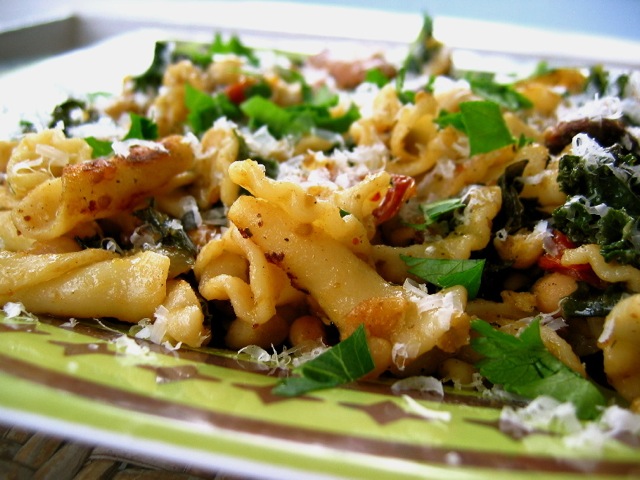
reference-image, l
(article, Keri Fisher)
Every family has their weekly dinner standards: meatloaf, roasted chicken, spaghetti and meatballs. In my house, it’s Clean Out the Fridge Pasta (COFP). The basic tenets of COFP are always the same: vegetables, meat, and beans are combined with a thin sauce of garlic, chicken stock, and extra-virgin olive oil. The mixture is then draped over some kind of hearty pasta like penne or orechiette. COFP seems pretty basic to me, which is why I was surprised when my sister suggested I write an article about it. “But it’s just exactly what it says: Use whatever you have in the fridge,” I argued. “Can I use this quarter-head of cabbage?” she asked. “Well, no,” I answered. “Too wet.” “How about carrots?” [%image reference-image float=right width=425 credit="Photo © Culinate" caption="Clean Out the Fridge Pasta can be any mix of carbs, protein, and veggies — in this case, campanelle pasta with sausage, tomatoes, and kale."] “No, too hard.” “How about this deli roast beef that’s about to go bad?” “Fine,” I said. “I get the point.” Here then, are my guidelines to make your own version of COFP the best it can be. Vegetables. Green vegetables work best: broccoli, asparagus, peas, even green beans. Leafy vegetables also work well, like spinach, kale, or broccoli rabe (my personal favorite). Of course, since this is something you’ll make out of whatever you have in your fridge, feel free to mix and match: a cup of frozen peas, half a bag of baby spinach, five stalks of asparagus. This is meant to be a quick weeknight dinner, so steer clear of long-cooking vegetables like carrots or beets. And since the dish is plenty starchy with the pasta and beans, stay away from root vegetables like parsnips, turnips, and potatoes. The aforementioned cabbage and its cousins (like bok choy or Brussels sprouts) aren’t a great fit due to their strong flavor and high moisture content. Leftover vegetables work great in this dish; simply add them at the end with the beans. Meat. This, of course, is optional, but the options are nearly limitless, including chicken, turkey, beef, pork, lamb, and any kind of sausage. We always have boneless skinless chicken breasts in our refrigerator, so that’s usually what we use. My husband and I disagree on exactly what kind of meat to use; I prefer raw, whereas he prefers cooked, such as leftover steak or roast chicken. No matter how quickly you cook it, I find that precooked meat gets too tough during its second pass through a hot skillet. If you do decide to use cooked meat, stick to meats you can cut into at least 1-inch-thick pieces; thinner pieces (like those from deli meat) will cook too much and too fast. Beans. We’ve only recently started adding beans to COFP, but I can’t recommend them enough. They add great body to the sauce and wonderful flavor. I prefer white beans; cannellini or Great Northern beans are my favorites. Herbs. There are always lonely sprigs of herbs floating around my produce drawer, so I tend to mix and match: parsley and thyme, marjoram and thyme, basil and parsley. Let your taste buds be your guide here; you know if you like the taste of certain herbs together better than any cookbook can tell you. Broth. My kitchen is never without chicken broth, which is what I always use, but of course, vegetable or any other kind of meat broth will do. [[block(sidebar). h1. Featured recipe]] Aside from the broth, the sauce ingredients are all essential and the technique unvaried. Get out two pots: a saucepan for the pasta and a skillet for the sauce. Heat the pasta water to boiling while you sauté chopped garlic in olive oil until golden and aromatic. Add the pasta to the saucepan; add the meat to the skillet. (I also like to toss some red pepper flakes in with the meat; if you really hate them, leave them out, but they add complexity and not too much heat.) Let the pasta burble away and sizzle the meat until it’s cooked or heated through, then remove the meat to a plate. Add your chosen vegetables to the saucepan while the pasta is finishing cooking. Put the stock in the skillet and reduce by half, then toss in some butter. Drain the pasta and the vegetables, then add everything back to the skillet and dress it all with olive oil, Parmesan, beans, herbs, and salt and pepper. Two pots, easy clean-up. I love this dish because it’s so quick and obviously versatile. In fact, I love it so much that I’ve been known to buy specific ingredients for it at the store and make it without actually cleaning out the fridge. Which means only one thing: Clean Out the Fridge Soup is in my near future. p(bio). Cookbook author Keri Fisher (One Cake, One Hundred Desserts) has written for Saveur, Gastronomica, and Cook's Illustrated. She lives outside Philadelphia with her sister, her husband, and her three children, and keeps a blog about living in a communal household.

reference-image, l